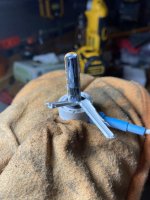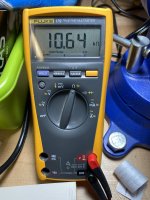- May 23, 2015
- 24,575
- Pool Size
- 16000
- Surface
- Plaster
- Chlorine
- Salt Water Generator
- SWG Type
- Pentair Intellichlor IC-60
I had to replace my water temperature sensor (Pentair 10k thermistor) as the wire got chewed through by a rat (I also reorganized a lot of the control wiring around my pad). But when I went to pull the thermistor from the discharge pipe, I noticed it was very hard to take out. At first I thought maybe the PB had drilled the hole a little too small but when I finally finagled the thermistor out, this is what I found -
This sensor is over 8 years old but I thought that it was interesting how the body is swollen & cracked. It almost looks like freeze expansion damage but we have never really had much of a hard freeze event here and anytime temps have gotten low, the freeze protect kicks in and circulates pool water. I think the coldest my pool water has ever gotten is 38F. Seems a bit odd to me ... Any who, the probe has been replaced and the wiring is bundled up now all in flexible wiring wrap so as to deter critters, or at least make their target harder to get at. Looks like I'll be placing some snap traps around the pad to take out the critters .... chunky peanut butter in a snap trap, gets them EVERY TIME.
Pentair 10K Thermistor Failed View 2
Failed 10k water temperature sensor
Pentair 10K Thermistor Failed View 1
Failed 10k water temperature sensor
This sensor is over 8 years old but I thought that it was interesting how the body is swollen & cracked. It almost looks like freeze expansion damage but we have never really had much of a hard freeze event here and anytime temps have gotten low, the freeze protect kicks in and circulates pool water. I think the coldest my pool water has ever gotten is 38F. Seems a bit odd to me ... Any who, the probe has been replaced and the wiring is bundled up now all in flexible wiring wrap so as to deter critters, or at least make their target harder to get at. Looks like I'll be placing some snap traps around the pad to take out the critters .... chunky peanut butter in a snap trap, gets them EVERY TIME.





